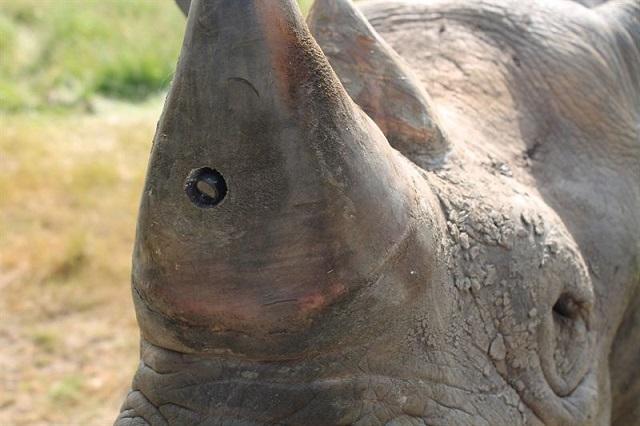

Rhinos will be fitted with satellite tracking collars and miniature cameras implanted in their horns to help catch poachers and act as a deterrent.
THE system invented by British scientist Dr Paul O’Donoghue allows 24/7 monitoring of the endangered animals via a video camera, GPS and 24-hour heart-rate monitor that triggers an alarm the moment a rhino is shot.
The Protect RAPID (Real-time Anti Poaching Intelligence Device) system could be trialled in South Africa in the next six to nine months and the device could later be adapted to other animals such as elephants and tigers.
Figures from Africa and Asia have shown dramatic crashes in the population numbers of rhino and elephant in recent years, with rhino poaching increasing more than 9,000-fold in South Africa alone since 2007. This is because effectively patrolling the massive areas of bush where they live is a near-impossible task for park rangers.
O’Donoghue, who has worked with endangered black rhino populations for more than 15 years, said: “Currently a rhino is butchered every six hours in Africa. The issues are many, but there’s far too much money at stake to believe that legislation alone can make the difference. We had to find a way to protect these animals effectively in the field; the killing has to be stopped.”
The system, described in a paper in the Journal of Applied Ecology, will be combined with rapid response teams of park rangers who will be helicoptered to the scene within minutes if the alarm goes off. Video footage captured by the miniature horn camera will then provide the evidence needed to secure a conviction.
“With this device, the heart-rate monitor triggers the alarm the instant a poaching event occurs, pin-pointing the location within a few metres so that rangers can be on the scene via helicopter or truck within minutes, leaving poachers no time to harvest the valuable parts of an animal or make good an escape,” says O’Donoghue. “You can’t outrun a helicopter – the Protect RAPID renders poaching a pointless exercise.”
O’Donoghue, a lecturer in biological sciences at the University of Chester, developed the anti-poaching system for the non-profit conservation organisation Protect, which plans to conduct the first trials next year.
- Chamisa under fire over US$120K donation
- Mavhunga puts DeMbare into Chibuku quarterfinals
- Pension funds bet on Cabora Bassa oilfields
- Councils defy govt fire tender directive
Keep Reading
Protect director Steve Piper said: “Proof-of-concept research has already been completed and we’re ready to take the device into the field. We expect to have the first rhino prototypes out within months and are just beginning development on versions for tigers and elephants.
“We hope to have a fully functional control centre established early next year. The figures make it painfully clear; there is no time to waste, the tide has to be turned and the Protect RAPID can do it. The only thing heading for extinction over the next decade is poaching itself.”
Mammal ecologist Dean Peinke, from the Eastern Cape Parks and Tourism Agency in South Africa, said: “We simply don’t know where or when poachers might strike. To effectively patrol these vast landscapes requires an army and still poachers could find a way through. They are well organised and equipped and they will find gaps in almost any defence because the rewards are so great.
“These devices tip the balance strongly in our favour. If we can identify poaching events as they happen, we can respond quickly and effectively to apprehend the poachers.”
Claire Bass, executive director of the animal protection organisation Humane Society International UK, which contributed funding to the project, said: “Reducing market demand is critical to safeguard wildlife long term, but it needs to be coupled with urgent, effective action to stop the current poaching crisis.
“The Protect RAPID could be a game changer in the increasingly desperate fight against poaching and the technology has the potential to be applied to other critically endangered species, including tigers and elephants.
“We are excited to have this opportunity to fund the project and hope other backers will join us to get the technology into the field as quickly as possible.”
-Online










